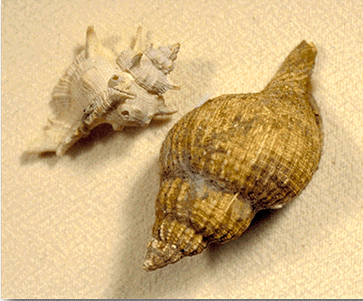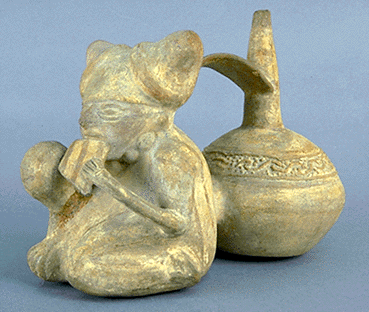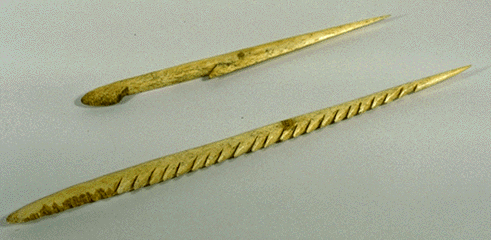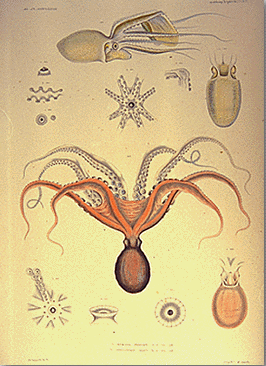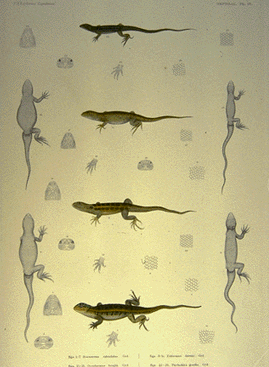An International Exploring Expedition
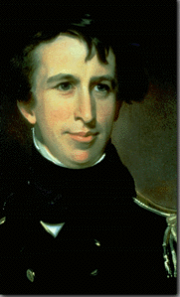
The first international scientific expedition sponsored by the United States circumnavigated the globe between 1838 and 1842, gathering natural history collections so vast they were estimated to weigh 40 tons. The U.S. Congress resolved to preserve these artifacts "collected at the expense of the government... as a memento of the science and energy of our navy, and as a means of illustrating and verifying the magnificent volumes which comprise the history of that expedition." Eventually the Smithsonian became home to these many specimens of natural history, ethnography and archaeology.

The expedition set sail from Hampton Roads, Virginia, on August 18, 1838, under the command of Lieutenant Charles Wilkes. The six vessels carried a youthful crew, many newly graduated naval officers, and nine civilian scientists. The scientific corps included two naturalists, a botanist, a philologist, a conchologist, a geologist, a horticulturist, and two artists. Their orders were spelled out by instructions from Navy Secretary Paulding: "Although the primary object of the Expedition is the promotion of the great interests of commerce and navigation, yet you will take all occasions, not incompatible with the great purposes of your undertaking, to extend the bounds of science, and promote the acquisition of knowledge."
From Virginia, the expedition visited the island of Madeira in the North Atlantic and took on supplies. Their next port of call was Rio de Janeiro, where Emperor Pedro II was celebrating his birthday amid great pageantry. The squadron petitioned the imperial government to provide an offshore island for magnetic observations, explored and charted islands, and collected birds, shells, and plants.
 Continuing southward, they reached Buenos Aires in early 1839. Lt. Wilkes wrote about Argentina in the Narrative of the United States Exploring Expedition, noting that the costume of the gauchos was strikingly picturesque, and shown to "full advantage, when the wearer is mounted, with the knife in his girdle and the lasso at his saddle bow, pressing forward in hot pursuit after the lusty bullock, flying for dear life over the broad grassy plain."
Continuing southward, they reached Buenos Aires in early 1839. Lt. Wilkes wrote about Argentina in the Narrative of the United States Exploring Expedition, noting that the costume of the gauchos was strikingly picturesque, and shown to "full advantage, when the wearer is mounted, with the knife in his girdle and the lasso at his saddle bow, pressing forward in hot pursuit after the lusty bullock, flying for dear life over the broad grassy plain."
At Good Success Bay in Tierra del Fuego, expedition officers landed with three boats to visit and trade with native peoples who had signaled them from shore -- the first opportunity to barter for native implements, clothing and jewelry. Wilkes commented that "Although they [the natives] attached great value to their bows and arrows, they were willing to exchange them" for pieces of iron and nails. This barren, bitterly cold region fascinated the scientists, who collected samples of a great variety of plant and animal life. Artist Joseph Drayton's drawing of a Fuegian native was reproduced in the Expedition's Narrative. He later recorded in notes and sketches various mollusks that were found, such as the Ranella. Tierra del Fuego's Orange Harbor was chosen as a base for exploring Antarctica, but on the first attempt the ships encountered dangerous weather, and the squadron was ordered to head for Valparaiso, Chile. Only five ships arrived at port: the Sea Gull, the smallest, had vanished somewhere in Antarctic seas.
 Sailing northward, they visited Callao. In Peru and Chile, they added new specimens of natural history and purchased typical costumes of the day, including that of a woman of Lima, saya y manto, and the ornate riding stirrups of both countries.
Sailing northward, they visited Callao. In Peru and Chile, they added new specimens of natural history and purchased typical costumes of the day, including that of a woman of Lima, saya y manto, and the ornate riding stirrups of both countries.
A ceramic whistling pot, a relic of the early Chimu empire, was apparently purchased in Lima. On the outskirts of Lima, the scientific corps investigated the ruined city of Pachacamac. They excavated a few small sites, recovering some pottery and fragments of cloth from mummy wrappings, and faithfully recorded their findings. In summer of 1839 the expedition headed due west to explore the islands of the Pacific and continue their voyage around the world.
These materials from all branches of science, including more than five thousand artifacts, were transported back to the United States. They were first exhibited for public view in the Great Hall of the Patent Office (now the Smithsonian's Portrait Gallery and Museum of American Art), and later transferred to the Smithsonian.
The scientific results of the expedition were published in a thirteen volume set, including these works on the Mollusca and Shells and Herpetology.

